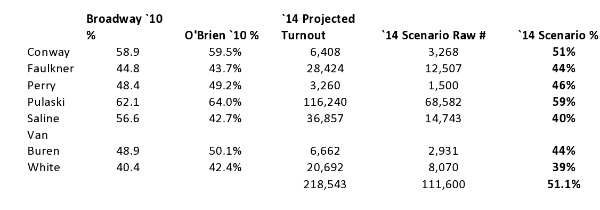Cook: By The Numbers, Tim Griffin Is Vulnerable
by July 12, 2013 12:01 pm 160 views
Republican Congressman Tim Griffin is vulnerable for defeat in 2014 and the best candidate to defeat him should likely come from outside Pulaski County.
I reached this conclusion based on analyzing election numbers from previous elections. Allow me to walk you through them.
In 2010 and 2012, Second District Democratic Congressional nominees Joyce Elliott and Herb Rule had significant weaknesses and both were crushed by Tim Griffin on Election Day. They received 38.3% and 39.5% of the vote respectively. In 2012, Tim Griffin received 55% of the vote, meaning 45% of the district voted against him. Still a win, but keep this in mind for later in the story.
2014, like 2010, is a mid-term election so the turnout will be very similar. As you recall, the 2010 election was a national Republican tidal wave and those waves swept across Arkansas.
That year, State Senator Shane Broadway and Pulaski County Clerk Pat O’Brien ran for Lt. Governor and Secretary of State respectively. In a non-tidal wave year, those two would have likely won their elections. While both lost statewide, both actually won the Second Congressional District, as it is currently redistricted.
Broadway won the district with 56.2% of the vote and O’Brien won with 55%. Broadway got a slightly higher percentage due to his Saline County base.
Reviewing the county-level numbers leads me to believe that Griffin could be defeated by a credible, and well-funded, Democratic candidate from outside of Pulaski County.
Take a look at the below spreadsheet:
For projecting 2014 turnout, I added 5% across the board to each county to account for increased population and registration. The two far-right columns outline the raw votes and percentage the Democratic nominee needs to win.
For the generic Democratic candidate, I have him/her doing worse than Pat O”Brien’s 2010 percentages in each county.
In counties such as Saline and White, I have the Democratic nominee losing by 20 points. Finally, with the exception of Conway and Pulaski, the generic nominee loses every county. Conway County still has strong Democratic tendencies.
Even with all these cards stacked against him/her, the generic Democratic nominee could still win the election with 51% of the vote. It’s tight, but doable.
The key to defeating Tim Griffin falls primarily to two counties: Faulkner and Pulaski.
Faulkner County is a political problem for Griffin. In 2012, he campaigned heavily on building the Keystone Oil pipeline and then this year in Mayflower a major oil pipeline burst open, spilling massive amounts of black gold. Griffin is now on the defense in that county. The right Democratic message in that county could inflict serious damage to Tim Griffin.
But notice even with this political problem, I still only have the Democrat garnering 44% in Faulkner County. For further perspective, Linda Tyler garnered 45.7% of the vote in that county in her challenge to State Senator Jason Rapert, so 44% is not beyond the realm of possibility for a 2014 nominee.
Pulaski County is also key. In 2012, the Democratic Congressional nominee, Herb Rule, had no name recognition, no money and was arrested for drunk driving in the middle of the campaign. Yet Rule still won Pulaski County with 50.7% of the vote to Griffin’s 44%.
Looking at it another way, 56% of Pulaski County voted against Tim Griffin by voting for Herb Rule or the Libertarian and Green Party candidates. In 2010, Shane Broadway got 62.1% in Pulaski County.
In my scenario, I have the Democratic nominee receiving 59% of the vote, still worse than Broadway’s 2010 performance, and just nine points better than a candidate arrested for drunk driving in the middle of the campaign.
In elections past, the best way to win the Second Congressional District was to be from Pulaski County so one could rack-up large win numbers to offset losing numbers from the rest of the district.
Now, I’m of the belief that in 2014 our ideal candidate comes from outside of Pulaski County, preferably Faulkner, Saline or White, to cut into Griffin’s base, while still racking up large Pulaski County numbers.
President Obama likely still looms large in the mid-term election, but he won’t be on the ballot, giving the Democratic nominee a little less heartache than a 2012 run would have.
Looking at the data, it’s clear that Tim Griffin could be defeated in 2014. Democrats need a strong candidate, preferably from outside of Pulaski County, who can raise the funds and highlight Griffin’s abysmal voting record.
But if there is no such Democratic candidate in 2014, then it’s all just numbers on a page.

